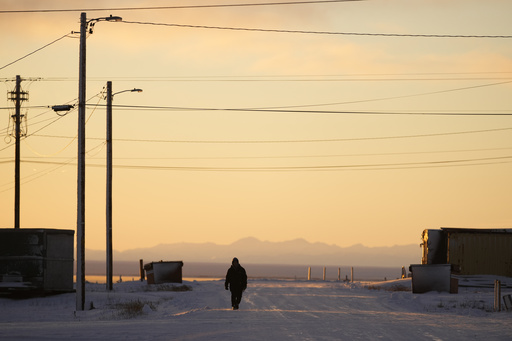
JUNEAU, Alaska — President-elect Donald Trump made several promises during his campaign to significantly increase oil drilling in the United States, a move that has been warmly received by political figures in Alaska. For many in the state, the oil industry is crucial to the economy, and there is a prevailing sentiment that the Biden administration has hindered efforts to revitalize the state’s declining oil production.
In the upcoming months, the conversation surrounding drilling in federal lands, particularly on Alaska’s North Slope, is expected to gain momentum. This includes discussions about the Arctic National Wildlife Refuge (ANWR), an area that environmentalists have consistently advocated to protect due to its pristine wilderness.
The debate surrounding drilling on the coastal plain of the refuge is contentious and has historically divided Alaska Native communities. Some individuals view potential new drilling as an opportunity for financial gain, while others express deep concern regarding the potential adverse effects on wildlife in an area they revere.
The Arctic National Wildlife Refuge is the largest of its kind in the United States, spanning an area in northeast Alaska comparable to the state of South Carolina. The region encompasses a diverse range of natural features, including mountains, plains, rivers, and forests, and serves as a habitat for various wildlife species, such as polar bears, caribou, and migratory birds.
Supporters of drilling claim that it could lead to a substantial economic boost, creating numerous jobs and generating significant revenue, along with increasing domestic oil production. The U.S. Bureau of Land Management has estimated that the coastal plain may hold between 4.25 billion to 11.8 billion barrels of recoverable oil; however, concrete data regarding the volume and quality of oil remains scarce. Additionally, there are concerns about whether companies would be willing to venture into projects that are likely to face legal challenges. Environmental advocates and scientists are calling for a transition away from fossil fuels to mitigate severe climate change effects.
The Arctic National Wildlife Refuge lies to the east of the Prudhoe Bay oil fields and the National Petroleum Reserve-Alaska. While the Biden administration has approved the controversial Willow oil project, it also restricted access to approximately half of the petroleum reserve for oil and gas leasing.
In efforts to explore drilling within the refuge, a well was drilled in the 1980s on lands allocated to Alaska Native corporations, though the results remain largely undisclosed.
Pursuing drilling in the coastal plain has long been a priority for several members of Alaska’s congressional delegation. The 2017 tax bill included provisions mandating two oil and gas lease sales by the end of 2024. The first lease sale occurred just before Trump’s administration ended; however, President Biden quickly directed Interior Secretary Deb Haaland to reevaluate the leasing program. This resulted in the cancellation of seven leases from the Alaska Industrial Development and Export Authority, with smaller firms relinquishing two additional leases. Legal proceedings are ongoing regarding the annulled leases.
Recently, the Biden administration unveiled a new environmental assessment in anticipation of the second required lease sale. It suggests offering the bare minimum land area permitted by the 2017 law, a proposal that has been criticized by Alaska’s Republican senators as undermining the intended goals of the legislation.
Opinions among Alaska Natives are sharply divided regarding drilling in the refuge. Leaders of the Iñupiaq community in Kaktovik advocate for drilling, while Gwich’in leaders from nearby communities emphasize the sacredness of the coastal plain, as it is vital for calving caribou populations they depend on. Galen Gilbert, the first chief of the Arctic Village Council, articulated a strong desire to protect the refuge, stating that it is essential for their way of life and the wellbeing of future generations.
Kaktovik leaders are committed to resisting any federal attempts to designate the land as sacred. Josiah Patkotak, the mayor of North Slope Borough, declared in an op-ed that the land never belonged to the Gwich’in people and emphasized that challenges to their sovereignty would be met with considerable opposition.
Oil remains integral to the economic stability of North Slope communities, highlighted by Nagruk Harcharek, president of Voice of the Arctic Iñupiat. He argued that responsible resource development could complement traditional subsistence lifestyles.
In light of Trump’s election, significant changes may be on the horizon. In a recent video, Governor Mike Dunleavy shared Trump’s commitment to advance a long-sought natural gas pipeline project, which has faced environmental opposition and stalled due to various challenges over the years.
Despite voters not being overwhelmingly supportive of Trump, Senator Lisa Murkowski noted that many appreciated his resource development policies’ potential benefits for Alaska’s economy. She anticipates a resurgence of economic opportunities in resource development with Trump’s return.
Dunleavy mentioned that Trump could reverse restrictions imposed by the Biden administration affecting oil and gas leasing on 13 million acres of the petroleum reserve. Harcharek’s organization is actively litigating these restrictions, alleging a disregard for the decision-making power of elected regional leaders.
Erik Grafe, an attorney for Earthjustice in Alaska, emphasized that the petroleum reserve was not established solely for oil extraction. There are other vital resources and environmental protections that must be considered as the state looks to the future. “Oil cannot be considered the only path forward; the state needs to strategize for a post-oil economy,” Grafe asserted.
